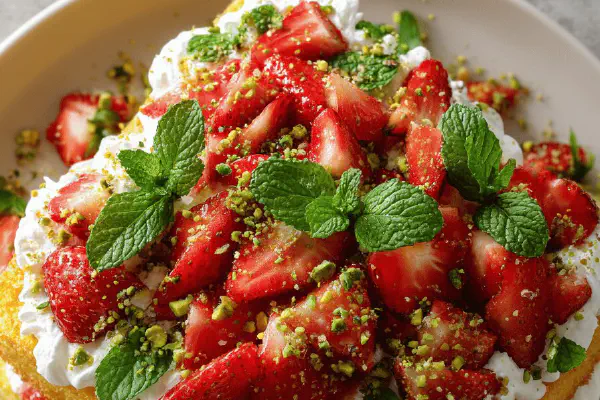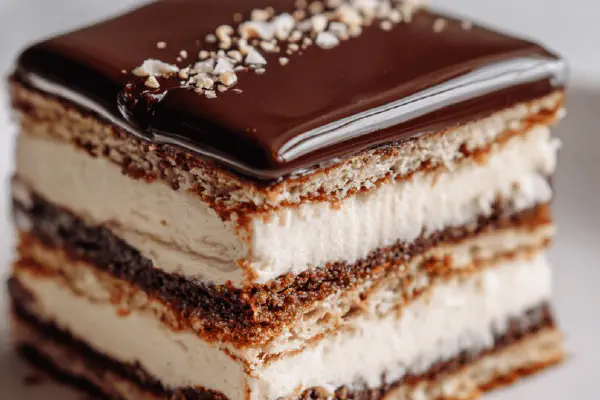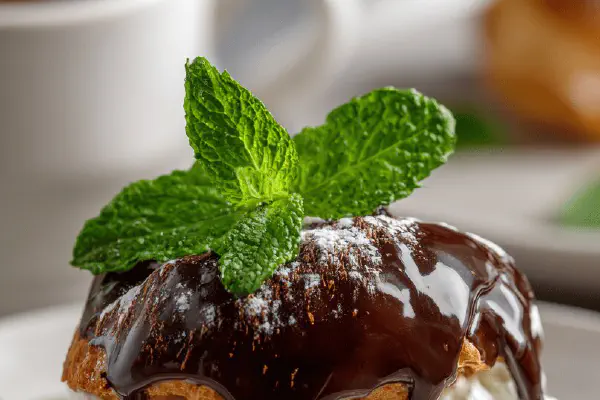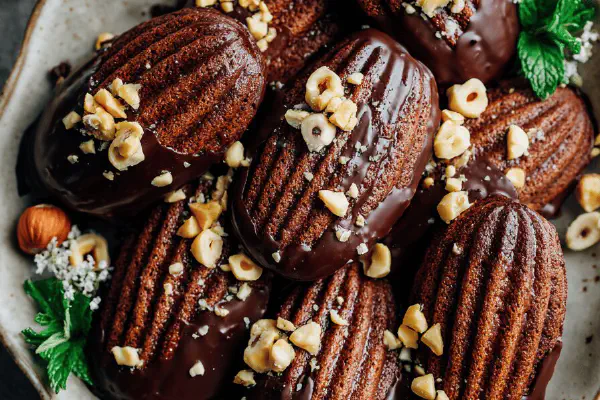Pear Chocolate Cake
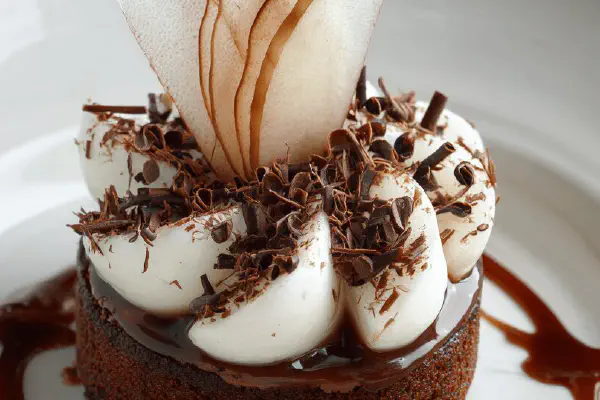
By Emma
Certified Culinary Professional
Ingredients
- 70 g (½ cup) all-purpose flour, sifted
- 28 ml (1 ¾ tbsp) unsweetened cocoa powder (exchange the 2 tbsp for natural cocoa for deeper flavor)
- 2 eggs
- 100 g (½ cup minus 1 tbsp) granulated sugar
- 1 can 796 ml (28 oz) of canned half pears in light syrup, drain pears and reserve syrup
- 25 ml (1 ⅔ tbsp) pear liqueur (Poire Williams or Belle de Brillet) - replace with pear brandy if unavailable
- 90 g (3 oz) 70% dark chocolate, chopped
- 315 ml (1 ¼ cup) heavy cream 35% fat, divided
- 12 ml (¾ tbsp) granulated sugar
- 15 g (½ oz) dark chocolate shavings (made with a vegetable peeler)
About the ingredients
Method
Cake
- Place oven rack mid-level. Preheat oven to 175°C (347°F). Line 20 cm (8-inch) springform pan with parchment. Skip buttering; parchment helps easy release without greasy mess.
- Whisk flour and cocoa powder together thoroughly, no lumps. Set aside.
- In a medium bowl, beat eggs and sugar on high speed about 9 minutes. Look for when volume triples, thick and pale, that ribbon effect when scoop and drop mix back onto surface. Can’t rush this step; air in batter critical for sponge lift.
- Sift dry blend over egg mix in two additions. Fold gently with spatula or whisk, no overmixing. Just enough to blend dry with wet. The trick - keep those air bubbles intact. Dump into prepared pan evenly.
- Oven time: 33–38 minutes. Bake until tester inserted near center comes out mostly clean with a few moist crumbs. Underbaking creates soggy texture; overbaking dries out sponge. Visual cues matter more than exact minutes.
- Cool the sponge completely IN the pan on rack. No hurry to unmold, fragile while warm.
Garnish and Assembly
- Mix 60 ml (¼ cup) reserved pear syrup with the pear liqueur until combined. Pour this syrup over cooled cake evenly, spooning gently to avoid soaking the edges too much and breaking the crust.
- Arrange the drained pear halves in a circular rose pattern: overlap glossy sides for a visual petal effect. Don’t overcrowd; each slice should get covered by mousse.
- In a small saucepan on medium heat, warm chopped dark chocolate and 125 ml (½ cup) cream. Stir frequently until smooth and glossy; don’t let it boil. If lumpy, off heat and keep stirring until melted. Cool the chocolate ganache slightly, stirring intermittently to prevent skin.
- In a separate chilled bowl, whip remaining 190 ml (¾ cup plus 1 tbsp) cream with sugar until soft peaks form. Not stiff. Soft peaks ensure mousse lightness.
- Fold chocolate ganache gently into whipped cream in 2 additions, keeping air. Pour this mousse evenly over pears and cake. Smooth top or rustic peaks, both fit here.
- Refrigerate at least 3 ½ to 4 ½ hours for mousse to firm well. Overnight fine, but if rushed chill longer in freezer wrapped well—15 minutes max to avoid ice crystals.
- Run knife around cake edge before releasing springform. Slide carefully onto plate. Finish with fresh dark chocolate shavings scattered atop for crunch and visual contrast.
- Store covered in fridge. Best enjoyed within 2 days. Freezing mousse can dull texture.
- Optional twist: swap half pears for poached quince slices – firmer fruit holds shape better under mousse. Liqueur swap with calvados adds warmth and depth.
Cooking tips
Chef's notes
- 💡 Flour sifted, cocoa folded gently — no lumps, no overmix. Air in batter must stay or sponge turns dense. Watch the texture, ribbon stage for eggs and sugar key. Can’t rush whisk time, volume means lift in oven. Use high speed mixer or elbow grease.
- 💡 Pear liqueur syrup soak just enough. Spoon slowly, uneven edges get soggy fast if soaked too much. Reserve syrup for moist surface without breaking crumb. Can swap liqueur for pear brandy, also add dash of calvados for aroma twist. Fresh poached pears need moisture control.
- 💡 Ganache heat low heat. Stir constantly. Too hot? Chocolate seizes, grainy mess no fix except scrap or add fat. If lumpy, off heat keep stirring to melt fully. Cool ganache before folding to avoid breaking whipped cream peaks.
- 💡 Whip cream soft peaks only. Stiff peaks turn mousse grainy, heavy. Soft peaks keep lightness. Folding ganache in two parts keeps air. Fold carefully, don’t rush or mix becomes flat paste. Cold bowl and cream preserve whip stability.
- 💡 Cake cooling in pan totally necessary. Remove warm cake = breaks, cracks. Let sponge cool fully on rack to keep shape. Knife warmed in hot water before releasing pan edges helps clean release. Chill mousse minimum 3.5 hours; freezing too long creates ice crystals.
Common questions
Can I substitute the pear liqueur?
Yes, pear brandy works, even a good pear extract in a pinch. Flavor changes slightly, less booze sharpness. Calvados adds warmth but different note. Adjust syrup sweetness accordingly.
How to prevent mousse graininess?
Don’t overwhip cream. Stop at soft peaks for light texture. Also cool ganache fully before folding. If ganache warm, breaks cream structure. Folding gently preserves air pockets, not beating hard.
What if cake is too dry?
Could be too much cocoa powder or overbaking. Pull tester earlier when crumbs still shiny, never fully dry. Syrup soak helps moisture but don’t drown edges or crust weakens. Sift flour carefully to avoid dense batter.
How best to store leftovers?
Keep covered in fridge, mousse stable 2 days tops. Freezing not great — mousse texture dulls, ice crystals form. Cake can hold a day outside fridge if well covered, but humidity affects crumb and cream stability.
